Linktree’s organic growth has been impressive over the last few years, but its organic traffic has dipped recently. What’s changed?
Let’s find out.

Linktree says it has over 35 million users.
It built its brand by creating a platform where content creators can share multiple links to their social media accounts or websites through a single bio page.
According to Ahrefs’ Site Explorer, the website receives ~2.7 million monthly organic traffic and has a Domain Rating (DR) of 93, making it a high-authority site.
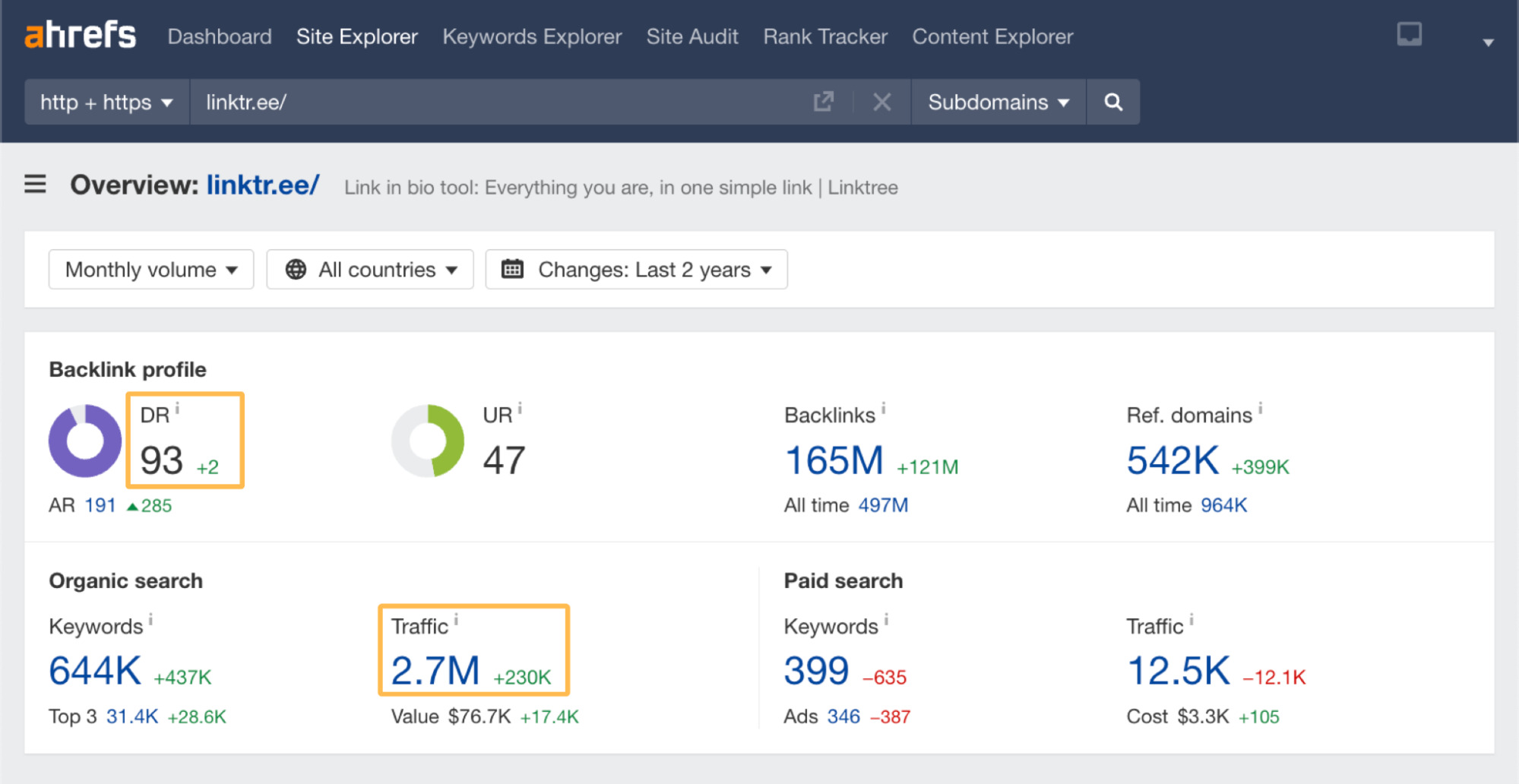
The idea behind Linktree isn’t new—websites like about.me started offering similar products a few years ago.
Linktree grew faster than these platforms, though, once influencers began using it as their preferred link in the bio.
For example, here’s The Rock, Dwayne Johnson, linking to his Linktree account on a major social network—Instagram.
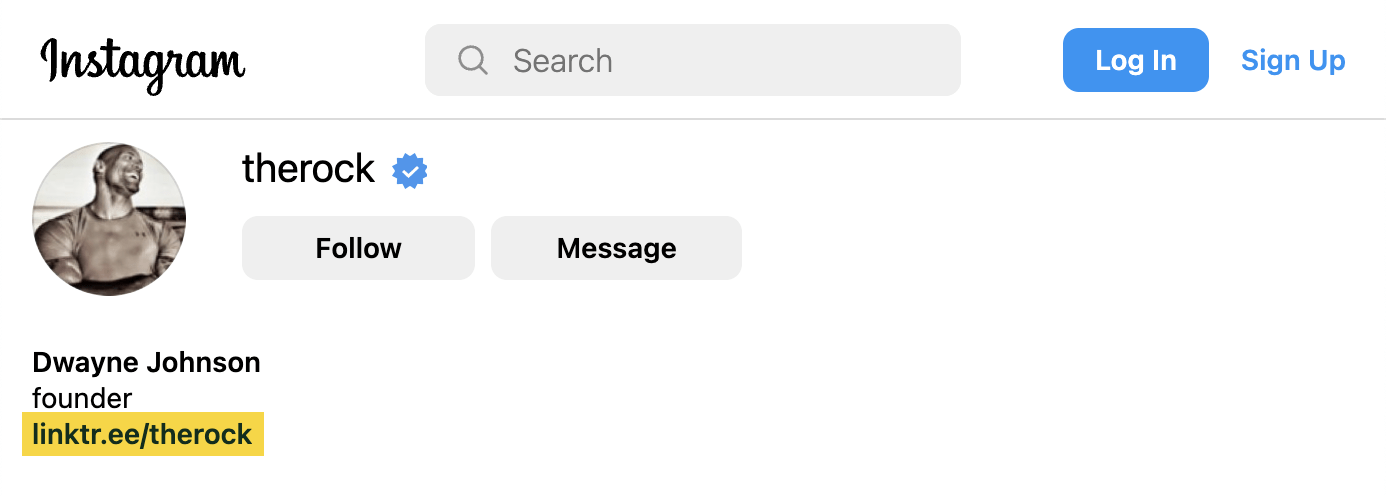
And here’s what his Linktree profile looks like.
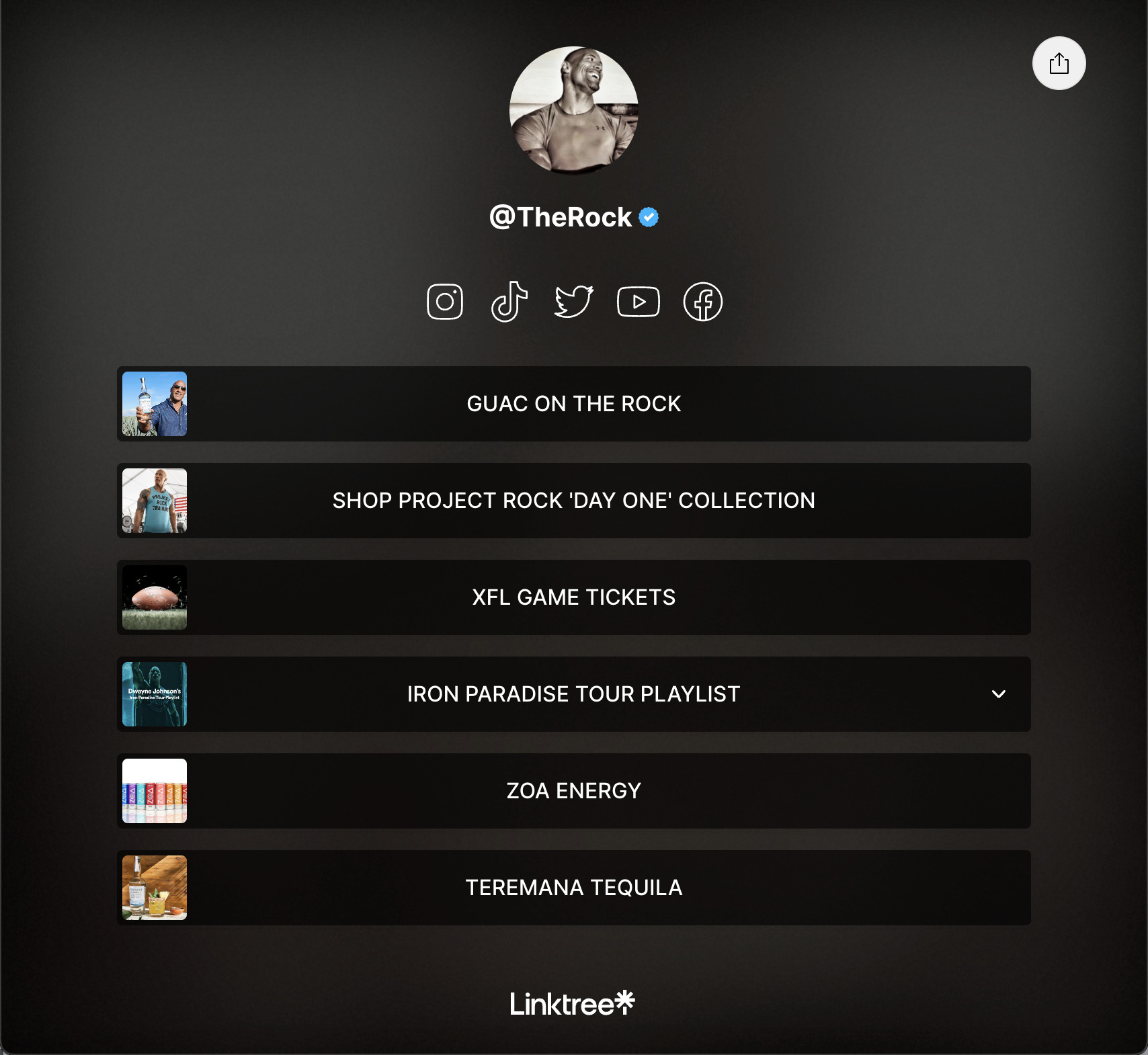
We can see that this content is clear and well presented.
But it’s worth noting that there are only six links to The Rock’s suggested sites, a profile photo, and some social media links—there’s just not much here. And this type of content forms the bulk of Linktree’s pages.
Linktree’s strength is that it solves a pain point of social media for many content creators—you can only have one link on most social media networks.
Another strength is that you don’t need to be a techie to set up a profile, making it attractive to social media influencers.
And as you can see from the screenshots, Linktree has spent a lot of time ensuring the design and user experience are good.
Now that we know a bit about Linktree, let’s look at its organic traffic in Ahrefs’ Site Explorer.
To do this, I’ve entered Linktree’s domain into the search bar, scrolled down to the overview, and selected “Avg. organic traffic.”
We can see the organic traffic rise and fall. Let’s look at the rise first.
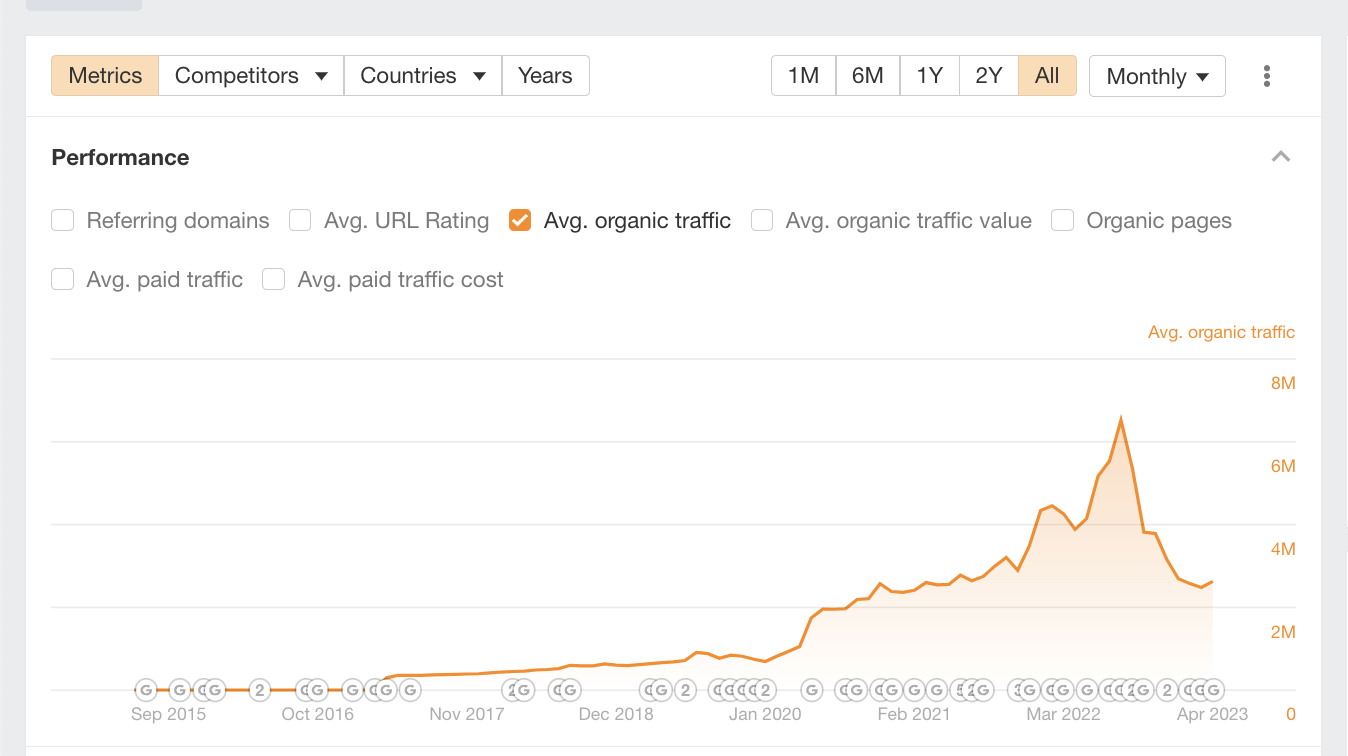
The site had a bump in organic traffic around March–April 2020. The traffic peak was in August 2022, reaching ~6.5 million.
What’s driving the traffic?
If we look at the site in the Top pages report in Site Explorer, we can start to understand where the traffic is coming from.
Let’s start with the basics—we can see that the website has a blog.

We can isolate blog articles using a “URL” filter containing /blog/.
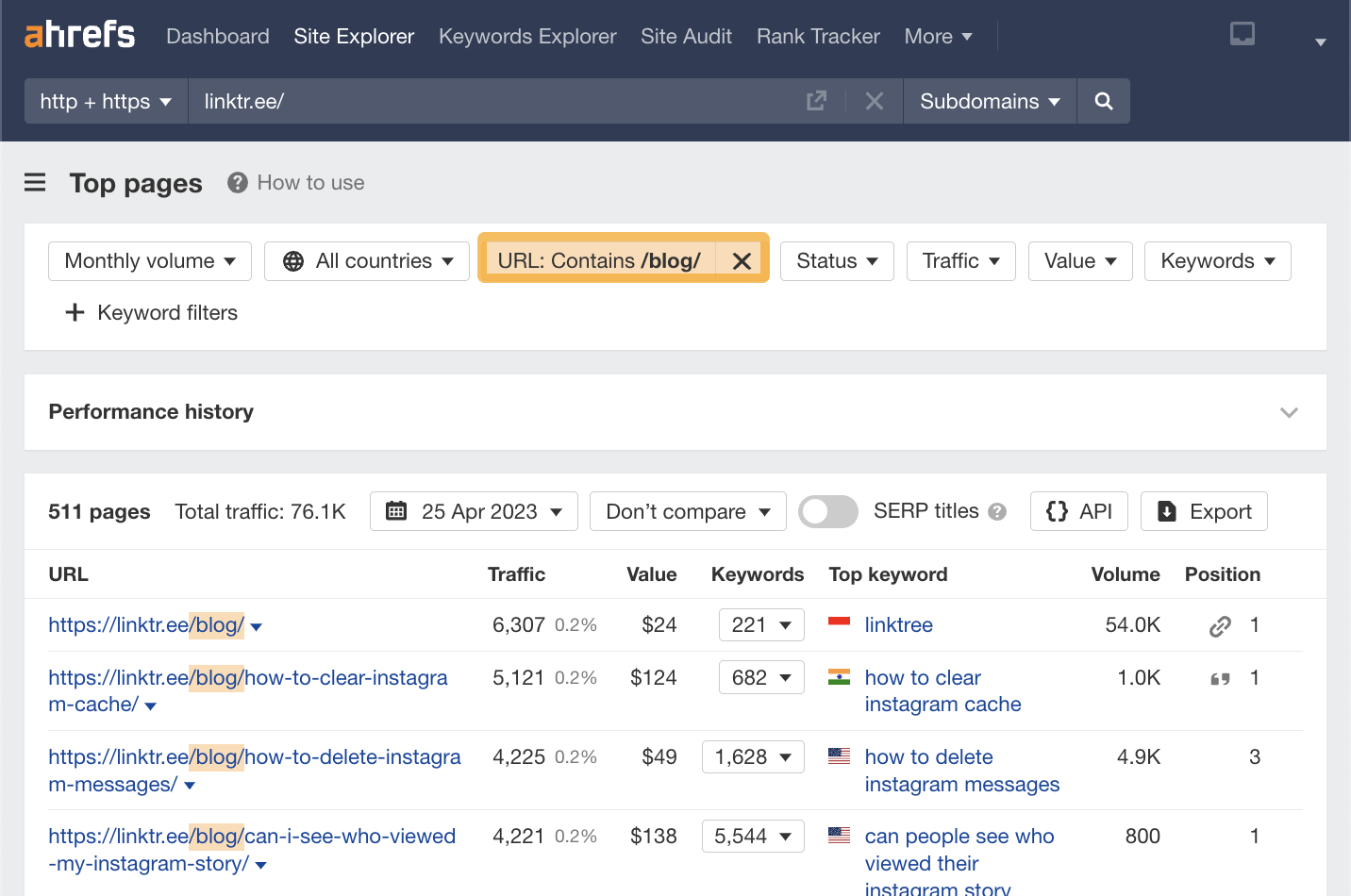
Doing this reveals that the blog has ~500 pages and drives 76,100 organic traffic—a fraction of the overall traffic.
So let’s continue investigating.
Another popular folder in the Top pages report has /s/ in the URL. Let’s see what type of pages we can find.

The /s/ folder pages are general pages explaining Linktree and its services.
These pages drive slightly more traffic than the blog at ~117,000. But again, it’s not that much.
If we remove all the filters, return to the Top pages report, and click the August 22, 2022, performance graph, we can see the most popular pages during this period.
Perhaps, unsurprisingly, most of the top pages appear to be Linktree users’ profile pages.
If we look at the Site structure report in Ahrefs’ Site Explorer, we can confirm this.

Most user profiles follow this format: linktr.ee/username. And we can see, using this report, that most of the traffic is coming from the home folder.
The homepage is also popular. Here, 22.7% of the traffic is going to it.
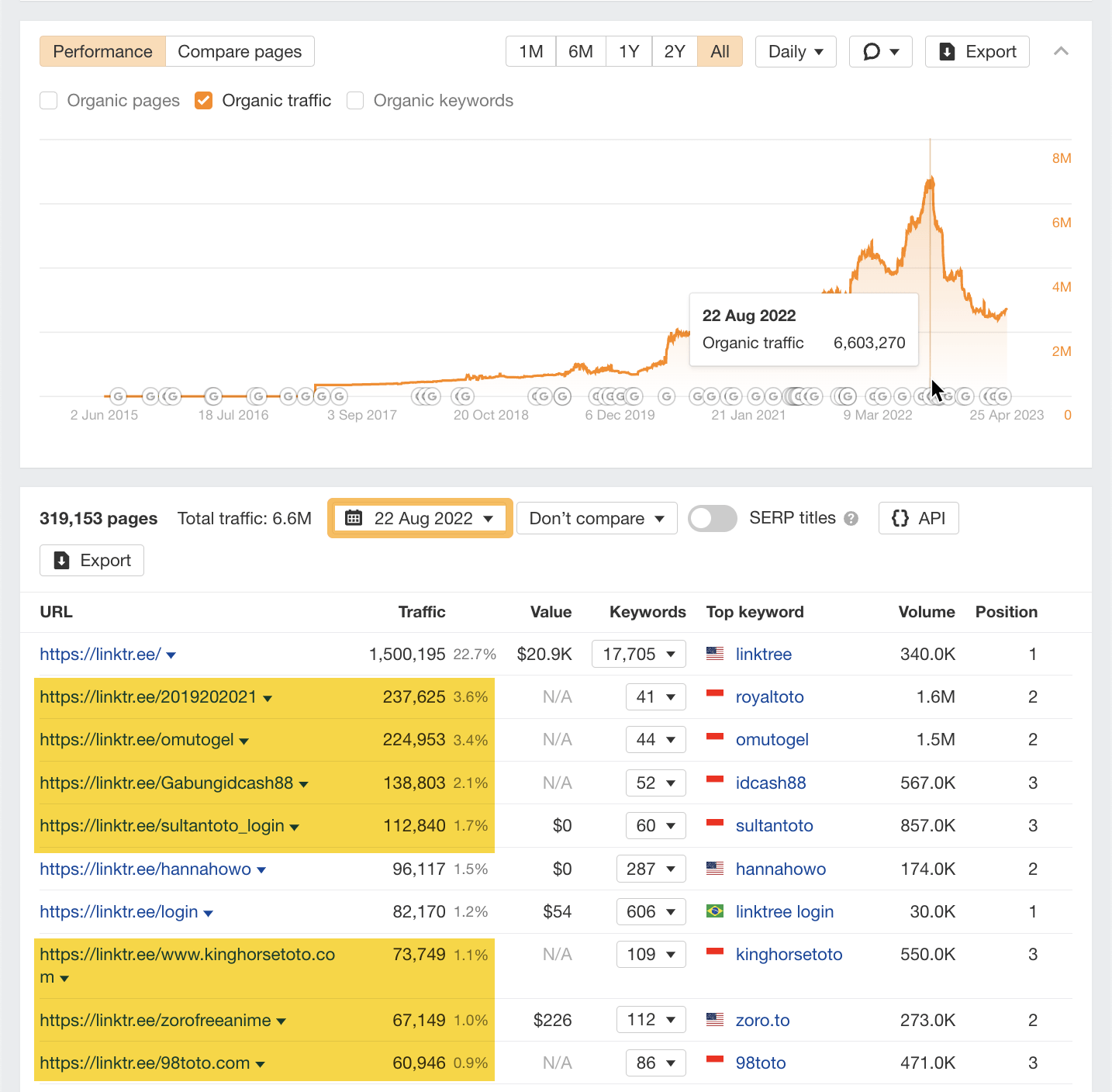
More interestingly, though, all of the highlighted top pages—or user profiles—have been taken down by Linktree due to “inappropriate use of the service.”
When clicking on these URLs in Ahrefs, I get the image below on Linktree.
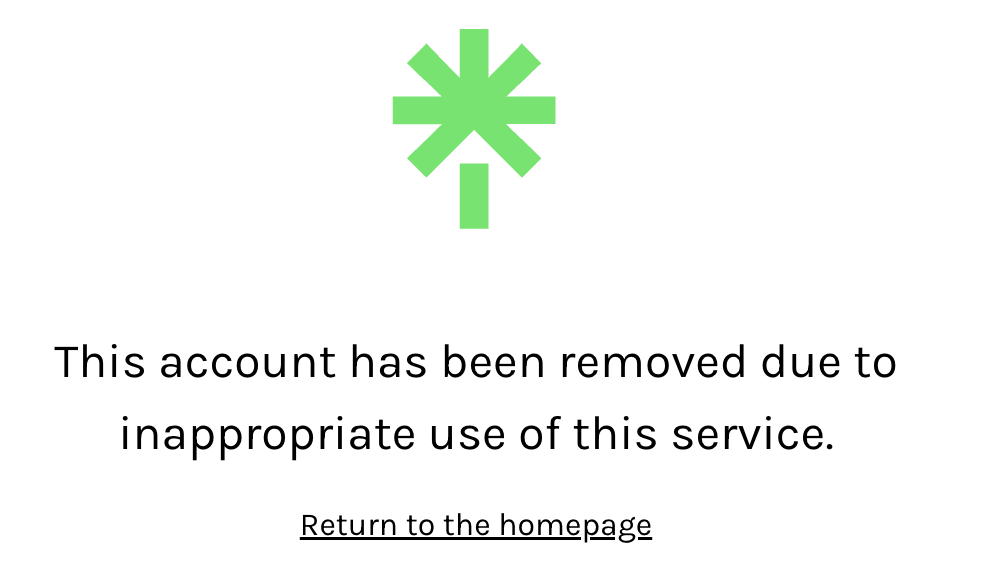
This small sample of pages shows that these profiles collectively drove almost as much organic traffic as the homepage.
So far, we’ve looked at Linktree’s rise. But why has its organic traffic dropped so much?
To understand this, we can compare the peak of Linktree’s organic traffic to the present to see the extent of the banned profiles’ impact on organic traffic.
I’ve added a “Compare” filter in Ahrefs’ Site Explorer to show the extent of the loss.
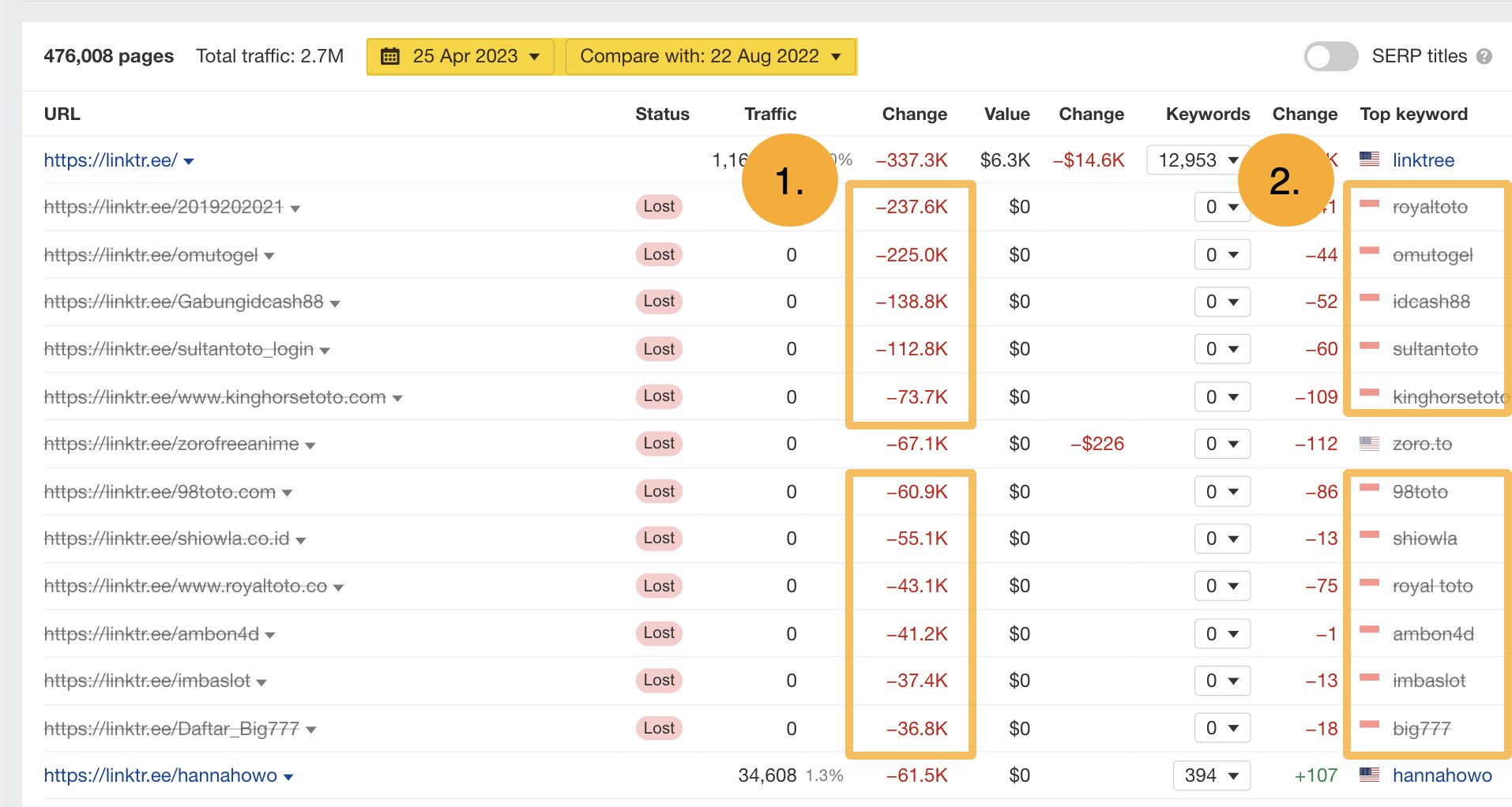
Using the “Compare” filter, we can see two things:
- The loss of the top traffic-driving profiles has resulted in significantly lower traffic to the site.
- Most of the removed user profiles are from Indonesia.
Traffic by country analysis
To look at the whole website’s traffic, we can look at “Traffic by country” in Site Explorer.

We can see that Indonesia has by far the most significant drop, followed by the United States.
If we click on Indonesia in Site Explorer’s Overview report, it will update the organic traffic graph to only show the organic traffic from that country.

This graph shows that the Indonesian market is primarily responsible for the rise and fall in organic traffic across the site.
So what happened?
My theory: risky (now removed) user profiles were driving the most traffic
Although it’s not clear at this stage why the top profiles were banned, it’s noticeable that most of the remaining top traffic-driving profiles are sharing NSFW links.
For example, here’s what the highest traffic-driving, non-banned user profile looks like:
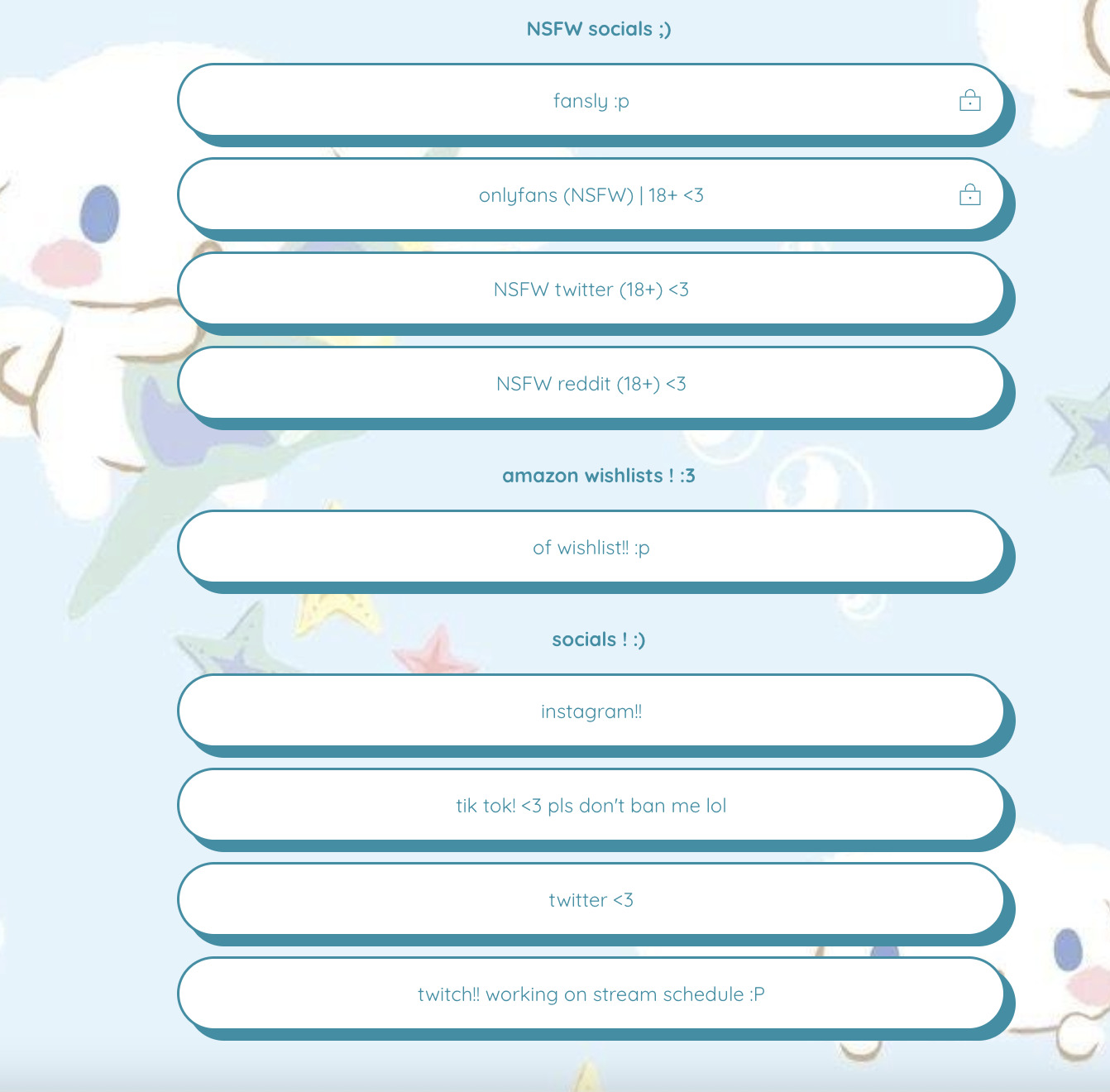
The majority of links here are for 18+ NSFW content. (My guess is that this is probably not what Linktree wants to be known for.)
Returning to the comparison we ran earlier, we can see that one of the top keywords is “kinghorsetoto.”

Let’s cautiously Google this phrase to see what comes up.

Well, it’s an Indonesian ****** site. Given the niche, it’s possible the site violated Linktree’s community standards.
After another search on Google, I discovered this Vice article, which suggested that Linktree removed *** workers from the website in early 2022.
The reason for the ban is explained below:
Per our company’s policies, the Linktree accounts banned stemmed from sharing a URL which violated Community Standards by sharing advertisements for the sale of real-life sexual services.
This ties in with our dates, so it’s possible that these banned profiles are a mix of *** workers’ profiles and anyone else who jeopardizes Linktree’s brand safety, like our Indonesian ****** site example.
According to the Vice article, Linktree was popular with *** workers because their content could often be removed from websites without warning, meaning that a third-party site like Linktree would enable them to have multiple backups if their content was removed.
As well as the mass removal of high-traffic user profiles, there also seems to be a correlation with the August 2022 Helpful Content Update.
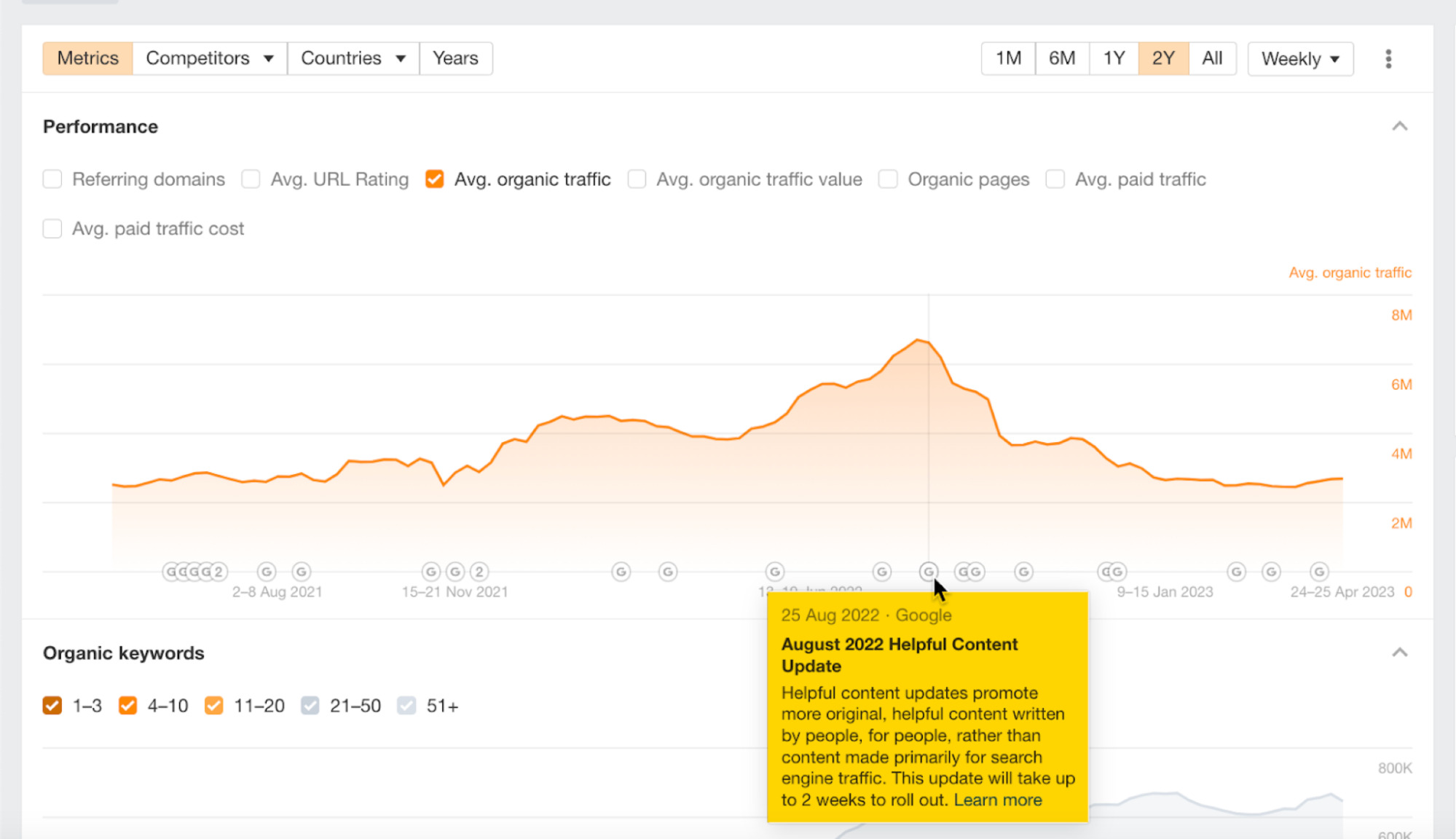
We have seen above that the majority of Linktree’s pages are links to other destinations, with what is, on most pages, minimal content.
Although this content serves the purpose of helping you get from A to B, it may be possible that Google feels this doesn’t fall under its definition of “helpful content.”
Room for improvement in SEO
We’ve looked at some of the bigger factors that could be responsible for Linktree’s recent fall in traffic, but what’s its SEO like?
In my opinion, it looks like Linktree could benefit by improving its SEO basics.
Here are a few examples of things that could be improved:
First, looking at the homepage with Ahrefs’ SEO Toolbar, I found that Linktree appears to not have a sitemap.xml file (at the time of writing).

Second, navigating over to the /templates page, you can see that it is using relative URLs for its canonicals.

Although there is nothing technically wrong here, it’s not usually considered best practice to use relative URLs in canonicals, and this has been confirmed by Google’s John Mueller.
Third, clicking around the menu, we can see the /marketplace page lacks a canonical tag completely. (This could be by design, but it seems a little odd to me if that is the case.)

Also, the “Discover” menu links to pages with “noindex, nofollow.”
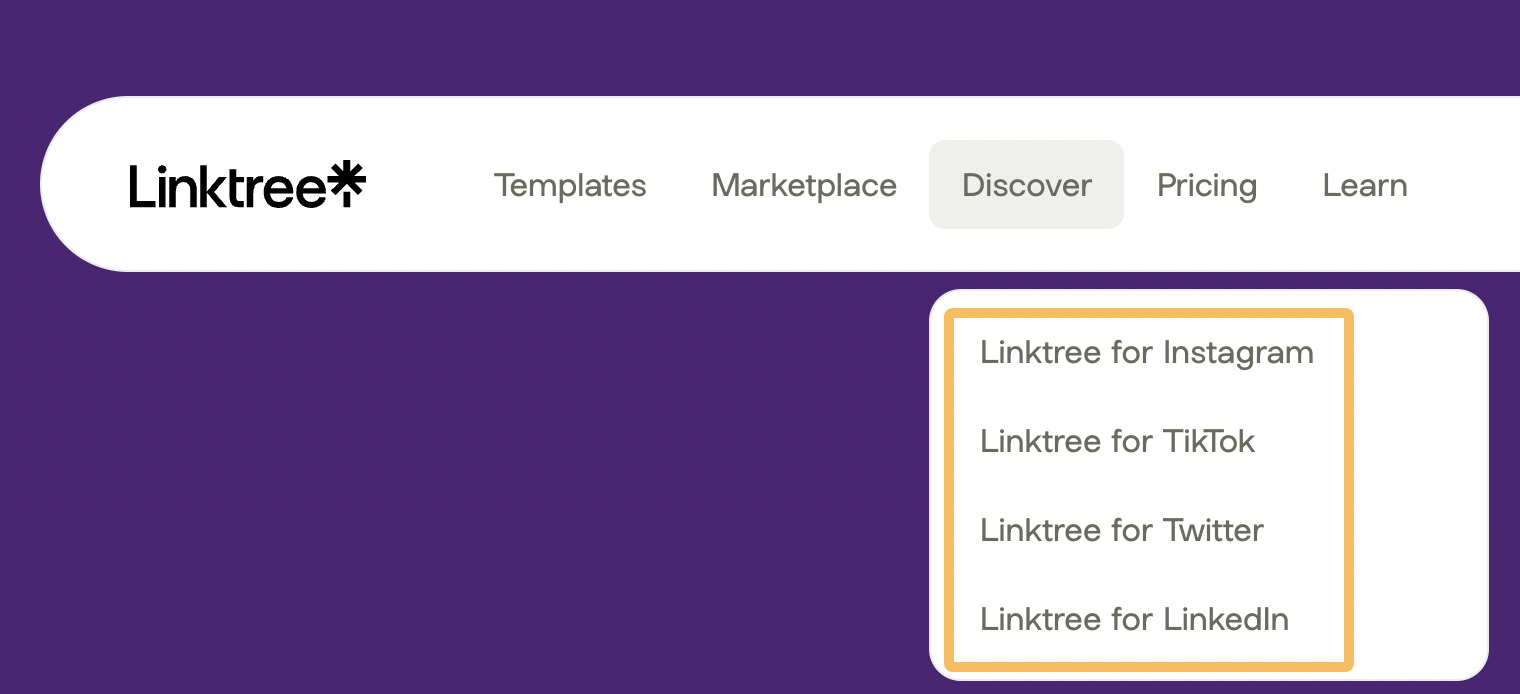
We can confirm this if we use the SEO Toolbar.
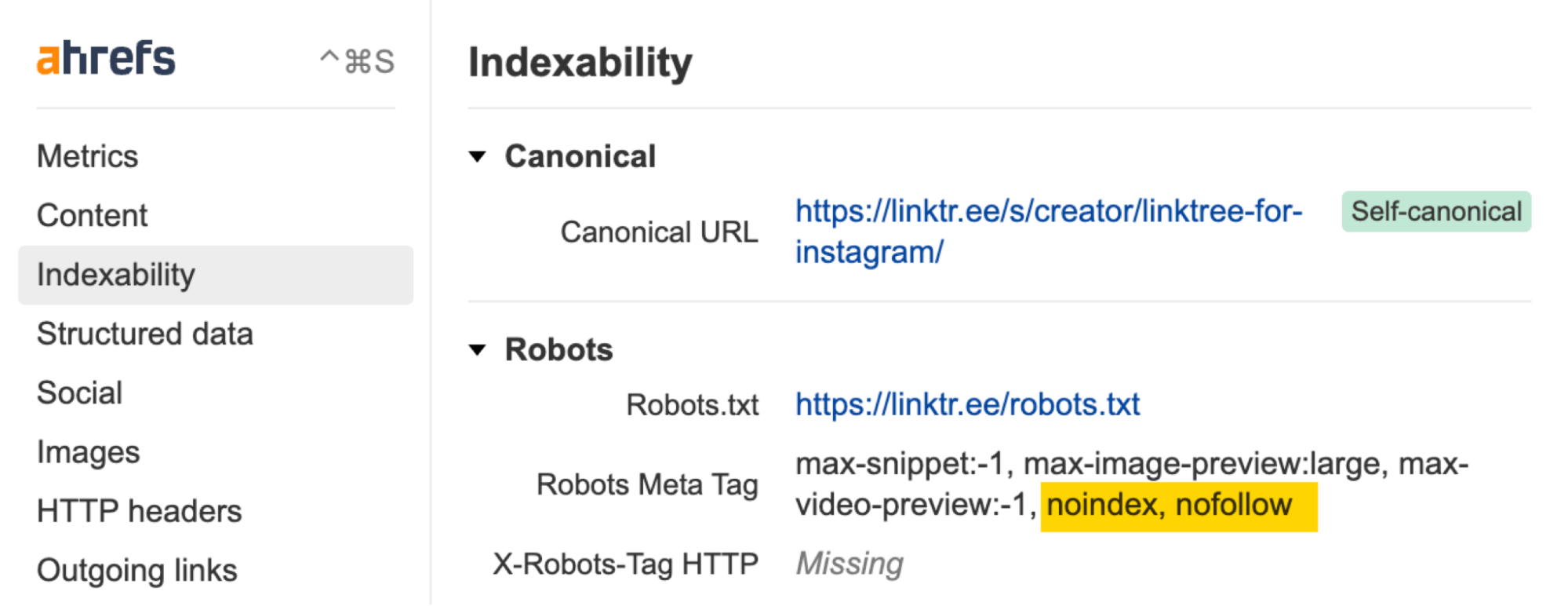
Setting a page to “noindex, nofollow” means that all search engines won’t be able to index this page. Again, it’s not particularly obvious why it did this.
It’s clear there are a few issues to look at here on a quick spot-check. But if we wanted to discover all of this site’s issues, we would need to run an audit using Ahrefs’ Site Audit.
Prioritizing design over SEO?
In terms of the look and feel of the site, it’s clear that Linktree has put a lot of effort into this aspect.
The site looks great. The design may have even inspired Wise’s most recent redesign. (Sadly, though, Google doesn’t rank sites based on the quality of the design.)

The future for Linktree in terms of organic traffic feels uncertain at the moment. But with a bit of work on the SEO basics, it could be improved.
Increased competition
Another factor to consider is that Linktree will face increased competition from big social networks. For example, recently, Instagram has added support for up to five links in the bio.

Although this doesn’t destroy Linktree’s business model, it may mean it loses some users who feel safer staying within the Instagram ecosystem.
Saying that, it hasn’t gone unnoticed by the Linktree Tiktok staff that Meta is still using a Linktree in its bio.
Another factor to consider is its smaller competitors—there are many of them now:
- later.com/link-in-bio/
- lnk.bio
- shor.by
- tap.bio
- feedlink.io
- linkinprofile.com
- milkshake.app
- campsite.bio
- bio.fm
- url.bio
- biolincs.me
- beacons.ai
Most offer a similar service to Linktree, so it must differentiate itself from its competitors moving forward, in my opinion.
How worried should it be about these smaller competitors? At the moment, not much.
If we put some of them into Site Explorer’s Organic competitors report, we can see that Linktree is way ahead of these smaller competitors in terms of organic traffic and organic traffic value.
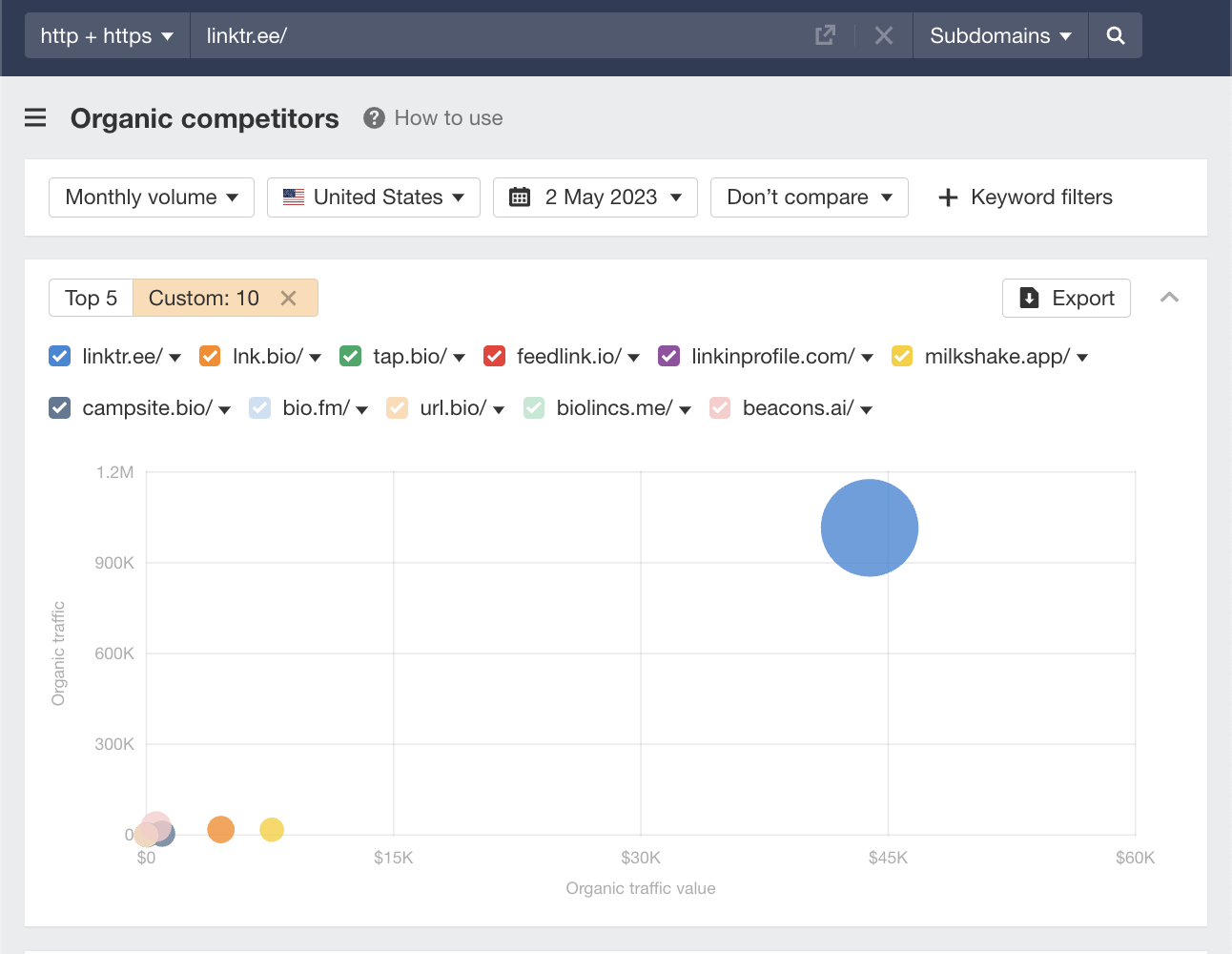
When it comes to other marketing channels, we can see it already has an active presence on TikTok. This may be considered more important to its business than SEO.
But saying that, at the time of writing, it appears that Linktree is looking to hire a new senior SEO strategist. So it is aware of the need for SEO.

Maybe a renewed focus on SEO is on the cards for the future?
Final thoughts
SEO is a funny old world. When I started this case study, I didn’t expect to be writing about *** workers and Indonesian ****** websites. But here we are.
Linktree’s SEO needs a bit of a spring clean. But as we’ve seen, the main fall in traffic is likely self-inflicted and due to the removal of “top traffic” user profiles.
Got more questions? Ping me on Twitter. 🙂
Source link : Ahrefs.com

